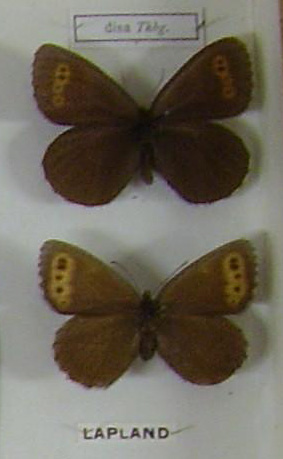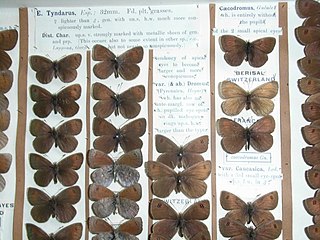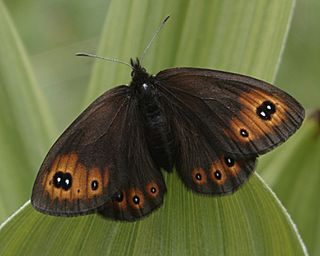
The Kanin Peninsula is a large peninsula in Nenets Autonomous Okrug, Russia.

Erebia is a Holarctic genus of brush-footed butterflies, family Nymphalidae. Most of the about 90–100 species are dark brown or black in color, with reddish-brown to orange or more rarely yellowish wing blotches or bands. These usually bear black spots within, which sometimes have white center spots.

Erebia euryale, the large ringlet, is a species of butterfly belonging to the family Nymphalidae.

Erebia ligea, the Arran brown, is a member of the subfamily Satyrinae of the family Nymphalidae. This brown is widespread in south-eastern and northern Europe. It prefers mixed woodlands at low altitudes. It is rarely seen in open areas. This species was first described by Carl Linnaeus in his 1758 10th edition of Systema Naturae, and the type locality is Sweden.

Erebia tyndarus, the Swiss brassy ringlet, is a European brush-footed butterfly species of the subfamily Satyrinae.

The Arctic ringlet or Disa alpine is a member of the subfamily Satyrinae of family Nymphalidae. It is associated with wet muskeg and bogs in subarctic and Arctic climates, and is often found near the tree-line. The larva overwinters twice before undergoing metamorphosis into an adult. It is found in Arctic Europe, Arctic European Russia, Sajan, Irkutsk, Yakutsk, Yablonoi and Arctic North America.

The brassy ringlets are a species group of ringlet butterflies in the genus Erebia. Though closely related, their monophyly is not completely resolved. Still, the brassy ringlets are taxa similar to E. tyndarus – the Swiss brassy ringlet –, and in many cases certainly close relatives. A notable trait of their genus is an ability to adapt well to cold and somewhat arid habitat, like taiga or regions with alpine climate. Optimal habitat in Eurasia, where most of the brassy ringlets are found, therefore occurs in two distinct belts – in the very north of the continent and in the Alpide belt – in interglacials, and in glacials in one periglacialic belt at lower altitude, in places interrupted by dry wasteland and deserts.

Erebia epipsodea, the common alpine, is a butterfly species of the subfamily Satyrinae of family Nymphalidae. It is found in North America from Alaska south through the Rocky Mountains to northern New Mexico and east across the prairie provinces to southwest Manitoba.
Erebia polaris, the Arctic woodland ringlet, is a butterfly of the family Nymphalidae. It is found in Lapland and boreal Asia.

Erebia rossii, the Arctic alpine or Ross's alpine, is a member of the subfamily Satyrinae of the family Nymphalidae. It is found in Arctic North America and northern Eurasia.
Erebia lafontainei, the reddish alpine or Lafontaine's alpine, is a member of the subfamily Satyrinae of the family Nymphalidae. It is found in northern North America from Alaska, Yukon, and western Northwest Territories as far east as Tuktoyuktuk.
Erebia anyuica, the scree alpine, is a member of the subfamily Satyrinae of family Nymphalidae. It is found in Siberia, in several isolated areas of Alaska, and in a band that extends across northern Alaska and northern Yukon to the Richardson Mountains on the Yukon/Northwest Territories border.
Erebia pawloskii, commonly known as the yellow-dotted alpine, is a member of the subfamily Satyrinae of the family Nymphalidae. It is found in North America in northern British Columbia, Yukon, and Alaska. It is also found in the Sayan Mountains, and from northern Mongolia to Yakutia and Kamchatka. The habitat consists of grassy areas in and above wet tundra, as well as bogs.

Erebia discoidalis, the red-disked alpine, is a member of the subfamily Satyrinae of family Nymphalidae. It is found in North America from eastern Quebec, through northern Ontario, and the northern Prairies to northern British Columbia, the Northwest Territories, Yukon, and Alaska. It reaches just into the northern U.S. between Michigan and Montana, and also occurs in Asia, where it has been recorded from the Chukot Peninsula to the eastern Sayan Mountains and Amur. The habitat consists of large, open, grassy bogs and other areas with acidic soils.

Erebia fasciata, the banded alpine, is a member of the subfamily Satyrinae of family Nymphalidae. It is found from central Siberia, through Alaska, Yukon, and mainland Northwest Territories and Nunavut to Hudson Bay. It also occurs on Banks Island and Victoria Island.
The Magdalena alpine is a member of the subfamily Satyrinae of the family Nymphalidae. It is found in North America from Montana, Colorado, Utah, and New Mexico, and in Canada in a small part of the Willmore Wilderness Park, Alberta, and adjacent British Columbia, in Stone Mountain Provincial Park in northern British Columbia, and on an isolated nunatak in Kluane National Park and Reserve, Yukon. The habitat consists of rockslides near vegetation, at or above the treeline.










